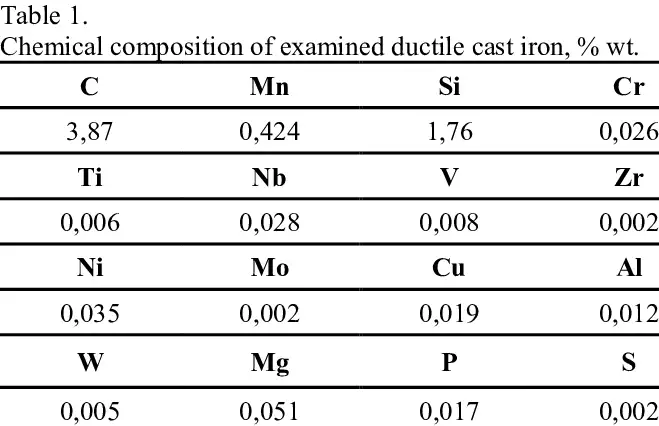Ductile iron, also known as nodular cast iron or spheroidal graphite iron, is a type of cast iron distinguished by its unique microstructure. Unlike traditional gray iron, which contains graphite flakes, ductile iron features graphite in the form of nodules. This structural difference imparts enhanced mechanical properties, making ductile iron a preferred material in various engineering applications.

1. Overview of Ductile Iron
Ductile iron is produced by adding small amounts of magnesium to molten iron, which induces the formation of spherical graphite nodules. This process significantly improves the material’s strength, ductility, and impact resistance compared to gray iron. The chemical composition of ductile iron can vary depending on the specific grade and intended application.
2. Typical Chemical Composition of Ductile Iron
The chemical composition of ductile iron typically includes:
-
Carbon (C): 3.0–4.0%
-
Silicon (Si): 2.2–3.0%
-
Manganese (Mn): 0.1–0.2%
-
Magnesium (Mg): 0.03–0.04%
-
Phosphorus (P): ≤0.04%
-
Sulfur (S): ≤0.02%
-
Copper (Cu): ≤0.40%
These elements contribute to the formation of the nodular graphite structure and influence the material’s mechanical properties.
3. Influence of Alloying Elements
-
Carbon: The primary element that forms graphite in cast iron. Higher carbon content can increase fluidity but may reduce strength.
-
Silicon: Promotes the formation of graphite and improves castability.
-
Manganese: Acts as a deoxidizer and helps in controlling the carbon content.
-
Magnesium: The key element that causes the graphite to form in nodules, enhancing ductility.
-
Phosphorus and Sulfur: Generally considered impurities; their levels are kept low to prevent brittleness.
4. Variations in Chemical Composition by Grade
Different grades of ductile iron have specific chemical compositions tailored to their intended applications. For example:
-
Grade 60-40-18:
-
Carbon: 3.4–3.9%
-
Silicon: 2.25–3.0%
-
Manganese: 0.15–0.35%
-
Sulfur: ≤0.025%
-
Phosphorus: ≤0.05%
-
-
Grade 80-55-06:
-
Carbon: 3.4–3.8%
-
Silicon: 2.35–2.75%
-
Manganese: 0.025%
-
Sulfur: ≤0.055%
-
Phosphorus: ≤0.05%
-
These variations affect the material’s mechanical properties, such as tensile strength and elongation.
5. Comparison with Other Cast Irons
| Property | Ductile Iron | Gray Iron | White Iron | Malleable Iron |
|---|---|---|---|---|
| Graphite Form | Nodular | Flaky | Cementite | Tempered |
| Tensile Strength | High | Moderate | Very High | Moderate |
| Ductility | Good | Poor | Low | Good |
| Castability | Excellent | Excellent | Poor | Good |
| Wear Resistance | Good | Moderate | Excellent | Good |
Ductile iron offers a balance between strength and ductility, making it suitable for a wide range of applications.
6. Applications of Ductile Iron
Ductile iron is used in various industries, including:
-
Automotive: Engine blocks, crankshafts, and suspension components.
-
Pipes and Fittings: Water and sewage pipes.
-
Heavy Equipment: Components subjected to high stress and wear.
-
Agricultural Machinery: Parts requiring high strength and impact resistance.
7. Heat Treatment and Its Effects
Heat treatment processes can alter the microstructure of ductile iron, affecting its mechanical properties:
-
Annealing: Softens the material, improving machinability.
-
Normalizing: Refines grain structure and enhances strength.
-
Austempering: Produces a bainitic microstructure, increasing toughness.
The choice of heat treatment depends on the desired balance of properties for a specific application.
8. Environmental and Economic Considerations
Ductile iron is recyclable and has a lower environmental impact compared to some other materials. Its cost-effectiveness and versatility make it an attractive option for manufacturers seeking durable and sustainable materials.
9. Future Trends in Ductile Iron Production
Advancements in alloying techniques and manufacturing processes continue to improve the properties of ductile iron. Research into alternative alloying elements and heat treatments aims to enhance performance characteristics, such as wear resistance and fatigue strength.
10. Frequently Asked Questions (FAQs)
Q1: What is the primary difference between ductile iron and gray iron?
A1: The primary difference lies in the graphite structure. Ductile iron contains spherical graphite nodules, which provide improved ductility and strength compared to the flake-like graphite in gray iron.
Q2: How does the addition of magnesium affect ductile iron?
A2: Magnesium is the key element that causes the graphite to form in nodules during the solidification process. This nodular graphite structure enhances the material’s ductility and impact resistance.
Q3: Can ductile iron be welded?
A3: Yes, ductile iron can be welded. However, preheating and post-weld heat treatment may be necessary to prevent cracking and ensure the integrity of the weld.
Q4: What are the advantages of using ductile iron over steel?
A4: Ductile iron offers similar strength to steel but with better castability and lower cost. It also provides excellent vibration damping and wear resistance.
Q5: Is ductile iron suitable for high-temperature applications?
A5: Ductile iron can withstand moderate temperatures. For high-temperature applications, grades with higher silicon content or alloyed ductile irons may be more suitable.
Q6: How does the chemical composition of ductile iron affect its mechanical properties?
A6: The chemical composition directly influences the microstructure and, consequently, the mechanical properties. For instance, higher carbon content can increase strength but may reduce ductility, while magnesium promotes the formation of nodular graphite, enhancing ductility and impact resistance.
Conclusion
Ductile iron’s unique chemical composition and microstructure provide a versatile material with a balance of strength, ductility, and castability. Understanding these properties allows engineers and manufacturers to select the appropriate grade and processing methods for their specific applications.
